Marcos V. Conde
RealX3D: A Physically-Degraded 3D Benchmark for Multi-view Visual Restoration and Reconstruction
Dec 29, 2025Abstract:We introduce RealX3D, a real-capture benchmark for multi-view visual restoration and 3D reconstruction under diverse physical degradations. RealX3D groups corruptions into four families, including illumination, scattering, occlusion, and blurring, and captures each at multiple severity levels using a unified acquisition protocol that yields pixel-aligned LQ/GT views. Each scene includes high-resolution capture, RAW images, and dense laser scans, from which we derive world-scale meshes and metric depth. Benchmarking a broad range of optimization-based and feed-forward methods shows substantial degradation in reconstruction quality under physical corruptions, underscoring the fragility of current multi-view pipelines in real-world challenging environments.
Efficient Perceptual Image Super Resolution: AIM 2025 Study and Benchmark
Oct 14, 2025Abstract:This paper presents a comprehensive study and benchmark on Efficient Perceptual Super-Resolution (EPSR). While significant progress has been made in efficient PSNR-oriented super resolution, approaches focusing on perceptual quality metrics remain relatively inefficient. Motivated by this gap, we aim to replicate or improve the perceptual results of Real-ESRGAN while meeting strict efficiency constraints: a maximum of 5M parameters and 2000 GFLOPs, calculated for an input size of 960x540 pixels. The proposed solutions were evaluated on a novel dataset consisting of 500 test images of 4K resolution, each degraded using multiple degradation types, without providing the original high-quality counterparts. This design aims to reflect realistic deployment conditions and serves as a diverse and challenging benchmark. The top-performing approach manages to outperform Real-ESRGAN across all benchmark datasets, demonstrating the potential of efficient methods in the perceptual domain. This paper establishes the modern baselines for efficient perceptual super resolution.
Efficient Real-World Deblurring using Single Images: AIM 2025 Challenge Report
Oct 14, 2025Abstract:This paper reviews the AIM 2025 Efficient Real-World Deblurring using Single Images Challenge, which aims to advance in efficient real-blur restoration. The challenge is based on a new test set based on the well known RSBlur dataset. Pairs of blur and degraded images in this dataset are captured using a double-camera system. Participant were tasked with developing solutions to effectively deblur these type of images while fulfilling strict efficiency constraints: fewer than 5 million model parameters and a computational budget under 200 GMACs. A total of 71 participants registered, with 4 teams finally submitting valid solutions. The top-performing approach achieved a PSNR of 31.1298 dB, showcasing the potential of efficient methods in this domain. This paper provides a comprehensive overview of the challenge, compares the proposed solutions, and serves as a valuable reference for researchers in efficient real-world image deblurring.
Towards Unified Image Deblurring using a Mixture-of-Experts Decoder
Aug 08, 2025Abstract:Image deblurring, removing blurring artifacts from images, is a fundamental task in computational photography and low-level computer vision. Existing approaches focus on specialized solutions tailored to particular blur types, thus, these solutions lack generalization. This limitation in current methods implies requiring multiple models to cover several blur types, which is not practical in many real scenarios. In this paper, we introduce the first all-in-one deblurring method capable of efficiently restoring images affected by diverse blur degradations, including global motion, local motion, blur in low-light conditions, and defocus blur. We propose a mixture-of-experts (MoE) decoding module, which dynamically routes image features based on the recognized blur degradation, enabling precise and efficient restoration in an end-to-end manner. Our unified approach not only achieves performance comparable to dedicated task-specific models, but also demonstrates remarkable robustness and generalization capabilities on unseen blur degradation scenarios.
NTIRE 2025 Challenge on Efficient Burst HDR and Restoration: Datasets, Methods, and Results
May 17, 2025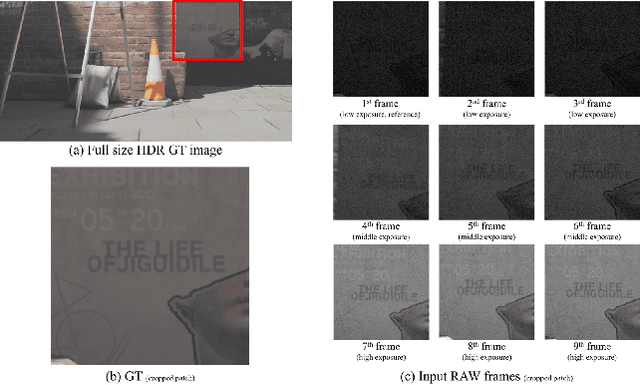
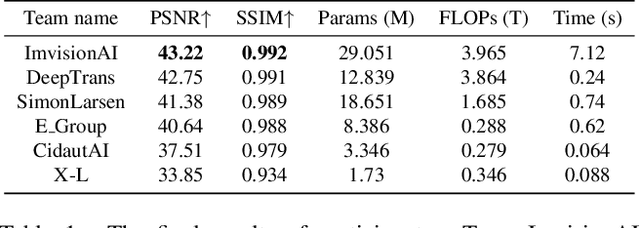
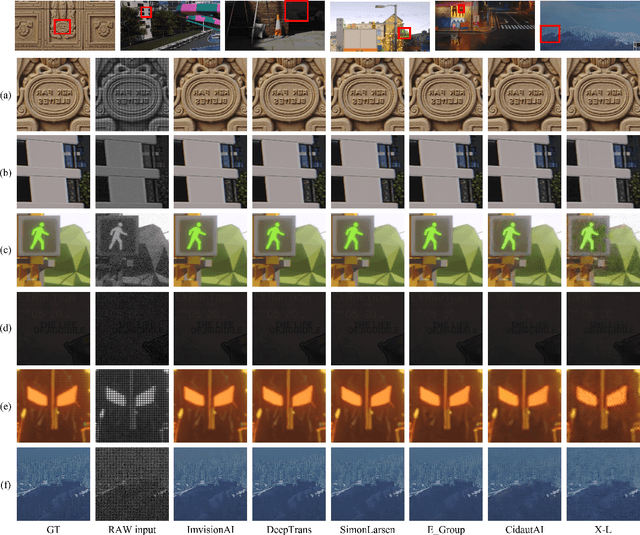
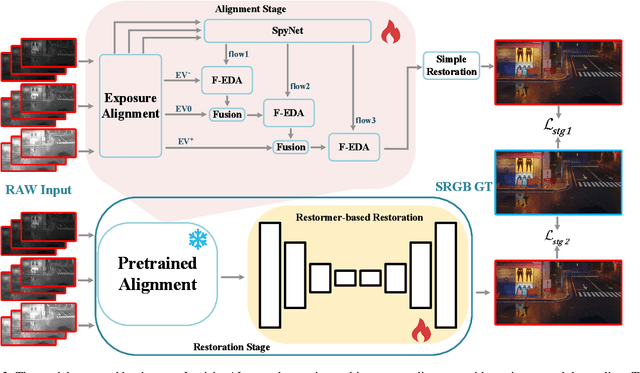
Abstract:This paper reviews the NTIRE 2025 Efficient Burst HDR and Restoration Challenge, which aims to advance efficient multi-frame high dynamic range (HDR) and restoration techniques. The challenge is based on a novel RAW multi-frame fusion dataset, comprising nine noisy and misaligned RAW frames with various exposure levels per scene. Participants were tasked with developing solutions capable of effectively fusing these frames while adhering to strict efficiency constraints: fewer than 30 million model parameters and a computational budget under 4.0 trillion FLOPs. A total of 217 participants registered, with six teams finally submitting valid solutions. The top-performing approach achieved a PSNR of 43.22 dB, showcasing the potential of novel methods in this domain. This paper provides a comprehensive overview of the challenge, compares the proposed solutions, and serves as a valuable reference for researchers and practitioners in efficient burst HDR and restoration.
NTIRE 2025 Challenge on Image Super-Resolution ($\times$4): Methods and Results
Apr 20, 2025Abstract:This paper presents the NTIRE 2025 image super-resolution ($\times$4) challenge, one of the associated competitions of the 10th NTIRE Workshop at CVPR 2025. The challenge aims to recover high-resolution (HR) images from low-resolution (LR) counterparts generated through bicubic downsampling with a $\times$4 scaling factor. The objective is to develop effective network designs or solutions that achieve state-of-the-art SR performance. To reflect the dual objectives of image SR research, the challenge includes two sub-tracks: (1) a restoration track, emphasizes pixel-wise accuracy and ranks submissions based on PSNR; (2) a perceptual track, focuses on visual realism and ranks results by a perceptual score. A total of 286 participants registered for the competition, with 25 teams submitting valid entries. This report summarizes the challenge design, datasets, evaluation protocol, the main results, and methods of each team. The challenge serves as a benchmark to advance the state of the art and foster progress in image SR.
NTIRE 2025 Challenge on Day and Night Raindrop Removal for Dual-Focused Images: Methods and Results
Apr 19, 2025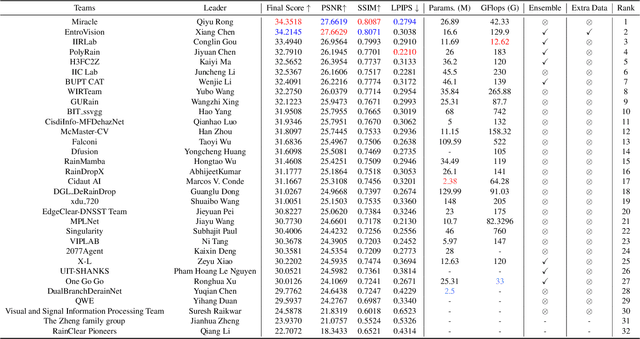
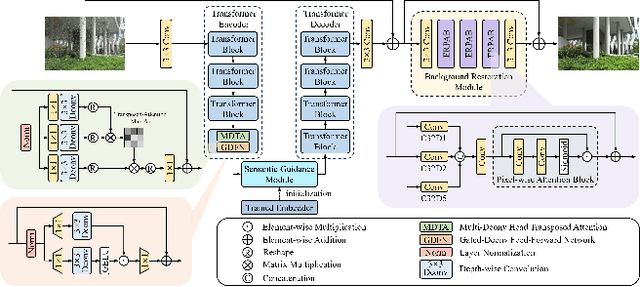
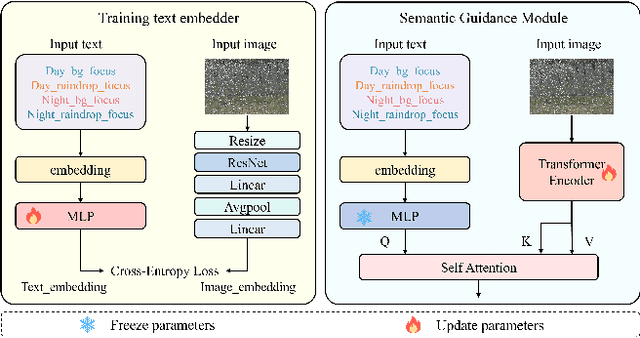
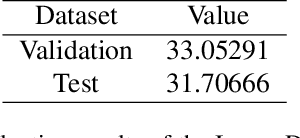
Abstract:This paper reviews the NTIRE 2025 Challenge on Day and Night Raindrop Removal for Dual-Focused Images. This challenge received a wide range of impressive solutions, which are developed and evaluated using our collected real-world Raindrop Clarity dataset. Unlike existing deraining datasets, our Raindrop Clarity dataset is more diverse and challenging in degradation types and contents, which includes day raindrop-focused, day background-focused, night raindrop-focused, and night background-focused degradations. This dataset is divided into three subsets for competition: 14,139 images for training, 240 images for validation, and 731 images for testing. The primary objective of this challenge is to establish a new and powerful benchmark for the task of removing raindrops under varying lighting and focus conditions. There are a total of 361 participants in the competition, and 32 teams submitting valid solutions and fact sheets for the final testing phase. These submissions achieved state-of-the-art (SOTA) performance on the Raindrop Clarity dataset. The project can be found at https://lixinustc.github.io/CVPR-NTIRE2025-RainDrop-Competition.github.io/.
The Tenth NTIRE 2025 Efficient Super-Resolution Challenge Report
Apr 14, 2025Abstract:This paper presents a comprehensive review of the NTIRE 2025 Challenge on Single-Image Efficient Super-Resolution (ESR). The challenge aimed to advance the development of deep models that optimize key computational metrics, i.e., runtime, parameters, and FLOPs, while achieving a PSNR of at least 26.90 dB on the $\operatorname{DIV2K\_LSDIR\_valid}$ dataset and 26.99 dB on the $\operatorname{DIV2K\_LSDIR\_test}$ dataset. A robust participation saw \textbf{244} registered entrants, with \textbf{43} teams submitting valid entries. This report meticulously analyzes these methods and results, emphasizing groundbreaking advancements in state-of-the-art single-image ESR techniques. The analysis highlights innovative approaches and establishes benchmarks for future research in the field.
Bokehlicious: Photorealistic Bokeh Rendering with Controllable Apertures
Mar 20, 2025



Abstract:Bokeh rendering methods play a key role in creating the visually appealing, softly blurred backgrounds seen in professional photography. While recent learning-based approaches show promising results, generating realistic Bokeh with variable strength remains challenging. Existing methods require additional inputs and suffer from unrealistic Bokeh reproduction due to reliance on synthetic data. In this work, we propose Bokehlicious, a highly efficient network that provides intuitive control over Bokeh strength through an Aperture-Aware Attention mechanism, mimicking the physical lens aperture. To further address the lack of high-quality real-world data, we present RealBokeh, a novel dataset featuring 23,000 high-resolution (24-MP) images captured by professional photographers, covering diverse scenes with varied aperture and focal length settings. Evaluations on both our new RealBokeh and established Bokeh rendering benchmarks show that Bokehlicious consistently outperforms SOTA methods while significantly reducing computational cost and exhibiting strong zero-shot generalization. Our method and dataset further extend to defocus deblurring, achieving competitive results on the RealDOF benchmark. Our code and data can be found at https://github.com/TimSeizinger/Bokehlicious
FLOL: Fast Baselines for Real-World Low-Light Enhancement
Jan 16, 2025



Abstract:Low-Light Image Enhancement (LLIE) is a key task in computational photography and imaging. The problem of enhancing images captured during night or in dark environments has been well-studied in the image signal processing literature. However, current deep learning-based solutions struggle with efficiency and robustness in real-world scenarios (e.g. scenes with noise, saturated pixels, bad illumination). We propose a lightweight neural network that combines image processing in the frequency and spatial domains. Our method, FLOL+, is one of the fastest models for this task, achieving state-of-the-art results on popular real scenes datasets such as LOL and LSRW. Moreover, we are able to process 1080p images under 12ms. Code and models at https://github.com/cidautai/FLOL
 Add to Chrome
Add to Chrome Add to Firefox
Add to Firefox Add to Edge
Add to Edge